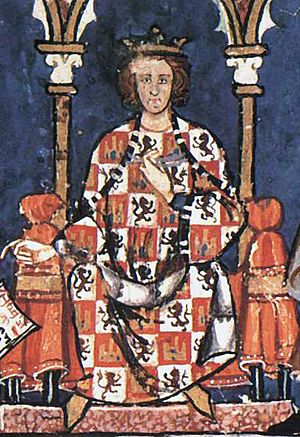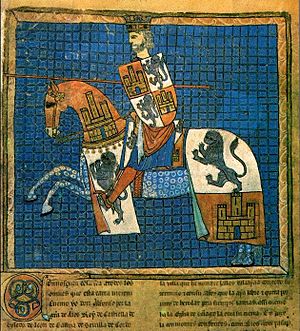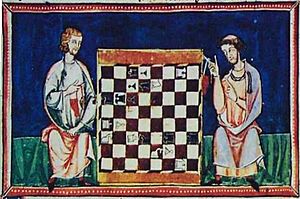Alfonso X of Castile facts for kids
Quick facts for kids Alfonso X |
|
|---|---|

Portrait of Alfonso X from the Libro de los juegos (1283)
|
|
| King of Castile and León | |
| Reign | 1 June 1252 – 4 April 1284 |
| Predecessor | Ferdinand III |
| Successor | Sancho IV |
| Born | 23 November 1221 Toledo |
| Died | 4 April 1284 (aged 62) Seville |
| Burial | Cathedral of Seville |
| Spouse | Violant of Aragon |
| Issue among others... |
Berengaria, Lady of Guadalajara Beatrice, Marchioness of Monferrat Ferdinand de la Cerda Sancho IV, King of Castile Peter, Lord of Ledesma John, Lord of Valencia de Campos Violant, Lady of Biscay James, Lord of Cameros Beatrice, Queen of Portugal Alfonso Fernández |
| House | Castilian House of Ivrea |
| Father | Ferdinand III of Castile |
| Mother | Elisabeth of Hohenstaufen |
| Religion | Roman Catholicism |
Alfonso X (born 23 November 1221, died 4 April 1284) was the king of Castile, León, and Galicia. He ruled from 1252 until his death in 1284. He is often called the Wise (el Sabio in Spanish).
Alfonso X was known for creating a court that loved learning. He encouraged people of different faiths, like Jews, Muslims, and Christians, to work together. He supported translating many books from Arabic and Latin into Castilian. This helped Castilian become an important language for learning, science, and law.
Alfonso was also a talented writer of poetry. His most famous work is the Cantigas de Santa Maria, which includes both poems and music. He was very interested in science, especially astronomy, and was sometimes called the Astrologer. He supported the creation of the Alfonsine tables, which were important astronomical charts. The Alphonsus crater on the Moon is named after him.
He also helped historians write about Spain's place in world history. As a lawmaker, he created the first law code in Castilian, called the Siete Partidas. He also started the Mesta, a group for sheep farmers. His reign ended with a civil war against his son, Sancho IV.
Contents
Life of Alfonso X
Early Years
Alfonso was born in Toledo, in the Kingdom of Castile. He was the oldest son of King Ferdinand III and Elizabeth of Swabia. His mother was related to the Holy Roman Emperor Frederick II.
Not much is known about his childhood, but he likely grew up in Toledo. For his first nine years, he was only the heir to Castile. Then, his grandfather King Alfonso IX of León died, and his father united the kingdoms of Castile and León. Alfonso began his military career at 16, fighting alongside his father.
In 1249, Alfonso married Violant, who was the daughter of King James I of Aragon. Before this, he had a relationship with Mayor Guillén de Guzmán, and they had a daughter named Beatrice. Between 1240 and 1250, he helped his father conquer several Muslim strongholds in Al-Andalus, including Murcia, Alicante, and Cadiz.
Becoming King
Alfonso became King of Castile and León in 1252 after his father died. The next year, he went to war with Portugal and took control of the Algarve region. King Afonso III of Portugal had to give up the land. However, they made an agreement: the land would be returned to their heirs if Afonso married Alfonso X's daughter, Beatrice of Castile. In 1261, Alfonso X captured Jerez. In 1263, he returned Algarve to the King of Portugal and signed the Treaty of Badajoz (1267).
In 1254, Alfonso X made an alliance with King Henry III of England. This helped Henry in his war against King Louis IX of France. In the same year, Alfonso's half-sister, Eleanor, married Henry's son Edward. With this marriage, Alfonso gave up his claim to the Duchy of Gascony.
Imperial Ambitions
In 1256, Alfonso was chosen by some princes to be the German king. This led to many complicated plans and a lot of money spent, but he never actually traveled to Germany. His rival, Richard of Cornwall, was crowned in Germany in 1257.
Alfonso faced financial challenges during his reign. His nobles also rebelled against him in 1272. In the end, the German princes chose Rudolph I of Habsburg as king in 1273. Alfonso gave up his claim to the Holy Roman Empire in 1275.
Challenges and Civil War
Alfonso often had disagreements with his nobles. Some historians believe he struggled to manage them. Others think he focused too much on his goal of becoming Holy Roman Emperor.
His oldest son, Ferdinand, died in 1275. Ferdinand left behind two young sons. Alfonso's second son, Sancho, then claimed he should be the next king. Sancho believed in an old custom where the closest male relative inherited the throne. Alfonso wanted his grandsons to inherit, but Sancho had the support of many nobles.
A difficult civil war began. In 1282, Alfonso was forced to accept Sancho as his heir. Only a few cities, like Seville, Murcia, and Badajoz, remained loyal to Alfonso. He died in Seville in 1284, leaving behind a kingdom still in conflict.
Economic Changes
In 1273, Alfonso created the Mesta. This was an organization for about 3,000 sheep farmers in Castile. Wool became a very important export for Castile, sometimes called "white gold." The Mesta helped manage the sheep herds and their grazing paths.
Lawmaking Efforts
Alfonso was a skilled lawmaker. He wanted to create a clear system of laws for his kingdoms. He worked on the Fuero Real, a code of laws. He also started creating the Siete Partidas, which was a very detailed law code for medieval Europe. However, it was not fully put into law until his great-grandson's time. Because of this important work, Alfonso X is one of the 23 lawmakers shown in the House of Representatives chamber of the United States Capitol.
Military Interests
From a young age, Alfonso X was interested in military life and chivalry. He went on military campaigns when he was just 16. He wrote about seeing a heavenly army fighting alongside Spanish soldiers, which shows his respect for military operations.
Alfonso's interest in chivalry can also be seen in his laws. In the Siete Partidas, he wrote that knights should be "of good linage and distinguished by gentility, wisdom, understanding, loyalty, courage, moderation, justice, prowess, and the practical knowledge necessary to assess the quality of horse and arms." He wanted to encourage strong fighters and ensure violence was used only for just reasons.
Alfonso's Court and Culture
Alfonso X created a court that encouraged learning and new ideas. He had many works translated from Arabic and Latin into Castilian. He helped make Castilian the main language for courts, churches, and official documents, rather than Latin. This translation work helped Spanish science, literature, and philosophy grow.
Translations and Knowledge
From the start of his rule, Alfonso hired Jewish, Christian, and Muslim scholars. Their main job was to translate books from Arabic and Hebrew into Latin and Castilian. Alfonso always watched over these translations himself. This group of scholars formed his royal scriptorium, continuing the work of the Toledo School of Translators. Their efforts made Castilian an important language for learning and helped create the modern Spanish language.
One of the first translations was a Castilian version of the animal story Kalila wa-Dimna. This book contained stories and sayings meant to teach a ruler how to govern well.
The scholars at Alfonso's court also focused on astronomy and astrology. They translated works about the magical properties of stones and talismans. They also translated important Arabic astrology books.
Astronomy and Science
Alfonso gained fame for his support of astronomy, which included astrology at the time. He had many Jewish translators who turned Arabic scientific texts into Castilian. His most famous scientific work is the creation of the Alfonsine tables. These tables were based on calculations by the astronomer al-Zarqali. Some believe these tables helped Copernicus develop his idea that the Earth orbits the Sun.
Because of his work, the lunar crater Alphonsus is named after him.
Historical Writings
Alfonso also ordered the creation of a collection of chronicles called the Crónica general, finished in 1264. This work aimed to create a general history using older chronicles, folklore, and Arabic sources.
His court also put together a work called General Estoria in Castilian. This was an attempt at a world history, using many sources like the Old Testament, and myths and histories from ancient Egypt, Greece, and Rome. This work was not finished and stops at the birth of Christ. Its main importance is how it translated many Latin texts into Castilian.
Alfonso X is also credited with the first picture of an hórreo, which is a traditional granary from northwest Spain. This image is found in his Cantigas de Santa Maria (song CLXXXVII).
Games and Music
Alfonso also had the "Libro de los Juegos" (The Book of Games) translated from Arabic into Castilian. He added illustrations to make it better. This book, finished in 1283, has a large collection of writings on chess, including over 100 chess problems and different ways to play chess.
Alfonso X also ordered or helped write many musical works. These include the Cantigas d'escarnio e maldicer and the huge collection Cantigas de Santa Maria ("Songs to the Virgin Mary"). These songs were written in Galician-Portuguese and are very important. The Cantigas are one of the largest collections of single-voice songs from the Middle Ages. They have 420 poems with musical notes, mostly about miracles attributed to the Virgin Mary.
Family
Alfonso's wife, Violant, was ten years old when they married. For several years, she did not have children, and people worried she could not. Alfonso almost had their marriage ended, but they went on to have eleven children:
- Berengaria (1253 – after 1284). She was supposed to marry Louis, the son of King Louis IX of France, but he died young. She became a nun.
- Beatrice (1254–1280). She married William VII, Marquess of Montferrat.
- Ferdinand de la Cerda, Infante of Castile (1255 – 1275). He married Blanche, King Louis IX of France's daughter, and had two children. Because he died before his father, his younger brother Sancho became the next in line for the throne.
- Eleanor (1257–1275)
- Sancho IV of Castile (1258 – 1295)
- Constance (1258 – 1280), a nun.
- Peter, Lord of Ledesma (1260 – 1283)
- John, Lord of Valencia de Campos (1262 – 1319).
- Isabella, died young.
- Violant (1265–1296). She married Diego López V de Haro.
- James, Lord of Cameros (1266 – 1284)
Alfonso X also had several children outside of marriage. With Mayor Guillén de Guzmán, he had:
- Beatrice, who married King Afonso III of Portugal.
With Elvira Rodríguez de Villada, he had:
- Alfonso Fernández de Castilla (1242–1281), also known as el Niño.
With María Alfonso de León, his aunt, he had:
- Berenguela Alfonso of Castile, who married Pedro Núñez de Guzmán but died young without children.
Images for kids
See also
 In Spanish: Alfonso X de Castilla para niños
In Spanish: Alfonso X de Castilla para niños





